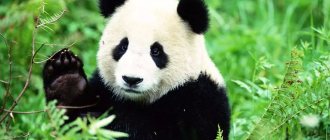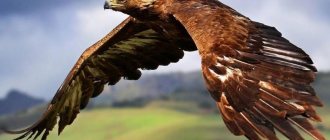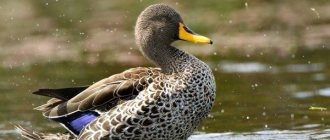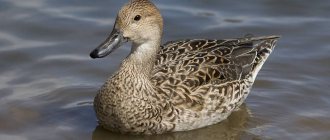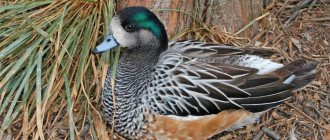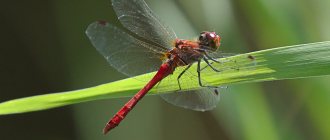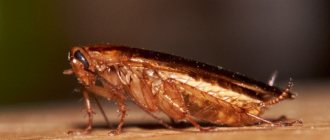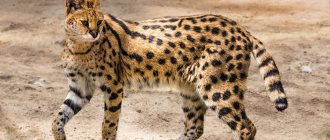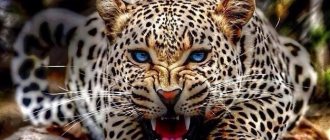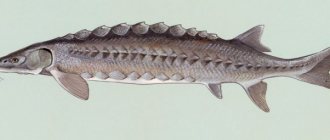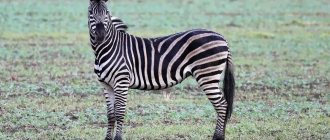Ducks, according to the classification of ornithologists, in nature form their own family of ducks. All individuals are waterfowl. For their habitat, they choose areas with ponds and dense coastal vegetation.
The habitat is very wide. They are distributed on all continents, with the exception of the North and South Poles. Birds can choose freshwater lakes and rivers, and sea lagoons. Reservoirs are the main sources of food.
In the reeds and cattails that grow on the shore, they hide from danger and build nests. What types of ducks are there? What do they eat and how do they reproduce?
Description of the bird
Domesticated ducks are very similar to their wild relatives, mallards. The birds have a powerful build, a wide chest and back. The size of the head and neck varies among species, as does the color of the plumage. Most duck breeds have solid colors - white or dark; motley ducks are less common.
— Advertising —
The wings of ducks are large, well developed with a wide span. The short tail is raised upward. The legs are strong and short. The beak is large.
Appearance
Since the wild duck belongs to the category of waterfowl, it is characterized by short wings, suitable for flying short distances and diving into water. The paws are also designed to suit their lifestyle. Between the 3 fingers there are membranes that help you row better. The average weight of an individual is about 2 kg. Ducks stay in the air by constantly flapping their wings, which helps develop their pectoral muscles.
They stay on the water thanks to air bubbles located between the feathers and accumulating in the lungs. The bird's feather remains dry thanks to fatty lubricant. It is secreted from the coccygeal gland, and then the birds apply lubricant to the feathers with their beaks. These birds have pronounced sexual dimorphism in appearance, especially noticeable in the winter and summer months.
Origin and domestication
According to the observations of scientists, all modern species of ducks descended from the once domesticated wild duck – the mallard. But as to when exactly this event occurred, opinions differ.
So, they call numbers from 1000 BC, when the domestication of wild ducks could begin in Asia, Europe, Africa and America. And at the same time, it is known that in the times of Ancient Rome, domestic ducks could fly, which is not typical for fully domesticated birds. In any case, ducks have been living in people's backyards for a very long time.
Habitat
The distribution range of ducks is very wide. You will not find them only in the harsh conditions of Antarctica. The main condition for the existence of wild ducks is the presence of a pond, since it is a source of food for these birds.
In addition, an obligatory factor is coastal vegetation (shrubs, reeds, wind-fallen trees, etc.), which hides the nest with masonry from prying eyes.
It’s easier with representatives of poultry - they live where conditions have been created for them.
Duck classification
— Advertising —
Domestic ducks are classified depending on their productivity into:
- meat breeds: Peking duck, Ukrainian gray duck, Rouen duck, black white-breasted duck, Aylesbury;
- egg-meat or meat-egg: mirror duck, khaki Campbell;
- egg breeds: Indian runners.
Who benefits from duck?
Having analyzed the biochemical composition of duck, we can say that, as a natural medicine, this meat is useful for people with:
- high cholesterol (niacin removes low-density lipoproteins from the body);
- the risk of cardiovascular diseases (B vitamins strengthen blood vessels);
- diabetes (nicotinic acid stabilizes blood glucose);
- osteoporosis and other diseases of bone tissue;
- weakened immune system;
- metabolic disorders;
- anemia;
- obesity;
- general weakness in the body;
- violation of enzymatic activity;
- malignant formations;
- pregnancy;
- diseases of the skin, hair, nails.
There is also an opinion that duck meat improves male potency. But we emphasize once again that all the beneficial properties of this meat are relevant only with moderate consumption of poultry. Excessive enthusiasm for a product can have the opposite effect.
Popular breeds
There are more than 80 breeds of ducks distributed around the world. The selection of these birds continues constantly with the aim of breeding species with certain qualities necessary for humans.
The most popular duck breeds today are:
Pekin Duck
The species was bred in China three centuries ago, from where the Peking duck was brought to Europe. This is one of the most productive and widespread meat breeds. The weight of adult females is from 3.5 to 4 kg, drakes reach 4-4.5 kg.
The bird is distinguished by a powerful physique with a wide back and chest, and a large head on a curved short neck. The Pekin is easily recognized by its convex forehead and flat, large orange beak. The bird's wings are large, its tail is small and raised up. The legs are short and strong. The plumage color is white, occasionally cream.
Indian Runners
An egg breed of ducks that was bred in India 2000 years ago. Egg production ranges from 200 to 250 eggs per year.
Indian runners differ from other species in their unusual body position: the birds raise their torso very high, while stretching their necks upward. They have a short beak and a tail that curves upward. The color of the plumage varies - from pure white, like the Peking duck, to piebald or with brown spots.
Khaki Campbell
The breed was developed by English poultry breeder Adele Campbell in the 19th century by crossing Rouen ducks with Indian runners. Belongs to egg-laying species.
The color of the breed's plumage varies from fawn to dark gray or white. The live weight of an adult drake is approximately 3 kg, the weight of a female is about 2.5 kg. The egg production of Khaki Campbell ducks can reach 350 eggs per year.
Muscovy duck (Cairina moschata)
Wild individuals live in South America, where they were domesticated and then spread by humans to all continents. The weight of an adult drake is from 4 to 6 kg, the female weighs up to 3 kg.
The color of the plumage is varied: from black or white to fawn, black with white wings. Dark Muscovy ducks are much more common. Red growths (“corals”) are visible above the beak and near the eyes of this breed.
General characteristics of the family
Ornithologists count 110 species of ducks. These are birds with dense contour plumage and thick body down. The contoured plumage gives the body a streamlined shape. Body down regulates body temperature.
Birds have a gland in the coccyx area that secretes fat. Birds lubricate their plumage with this fat, which allows them to keep their body and feathers dry. Ducks can quickly take off from the surface of the water and make long flights in rainy weather. All individuals of the duck family have the following description:
- The bird's body is elongated; its length can be up to 65 cm, but there are also dwarf species of ducks; their size barely reaches 30 cm;
- the neck is long, in a resting position it forms a zigzag with smooth transitions;
- wings are medium in size, tightly pressed to the body;
- flight muscles are well developed; the first and second flight feathers are longer than the others;
- short tail; it can be formed by 4-6 tail feathers;
- head elongated;
- the beak is large, flat, with teeth along the edges; they prevent ducks from completely closing their beaks; excess water comes out through the holes, all food remains in the beak;
- the limbs of all ducks are strongly moved towards the tail; they are covered with fine down, the metatarsals remain bare;
- wide membranes on the metatarsus; they allow birds to move quickly through the water;
- Ducks feed on algae, mosquito larvae, dragonflies, and small fish; some breeds eat frogs; individuals of some breeds often go ashore in search of food;
- to get food, ducks are able to dive, completely immersing their body under water; some birds dive to 6-8 m.
Appearance of a mallard duck
Ducks that live in cold and temperate climates are migratory. Individuals that live in hot climates remain sedentary. There is no need for them to fly away from their already familiar place. Reservoirs do not freeze, vegetation remains dense. Nature creates all the conditions for nesting and reproduction.
Ducks live in flocks, but during the mating season they look for mates. Individuals are monogamous and spend their entire lives in pairs. The exception is domestic poultry. In farm conditions, parental families are created artificially. Before migration, birds gather in a flock to carry out a difficult and long flight.
During the flight, a flock of ducks can connect with flocks of other birds: geese, swans. Such proximity does not bother them. From Europe and Central Asia, ducks fly to Egypt, India, and Iran. Birds that live on the coast of warm seas do not migrate.
The duck is a very hardy bird. It can cover more than 200 km at a time. In the air, the flock forms a wedge. The first to enter it are mature, strong individuals. The last to fly are the young ones. This hierarchy in the pack is not accidental.
Adults create air vortices with their wings, which support weaker birds and allow them to save energy when flying. If the flock consists of ducks and swans, then the school of swans is located in front of the ducks.
Content
A duck house is a dry and warm room without drafts, but well ventilated and lit throughout the year.
A bedding of at least 30 cm in thickness made of straw, sedge and peat is laid on the floor of the poultry house. Clean the room every day and ventilate it well.
A hole for ducks is made in the southern wall of the poultry house, measuring 40 by 40 cm. And it is taken out to a walking area, which must be fenced with an aviary one meter high. In summer, ducks are also walked on the water, where a fence is made a meter under the water and half a meter above its surface. A summer place for walking ducks should be in the shade.
In winter, in calm weather and at temperatures above -10 ° C, the ducks are also allowed out for walking, for which purpose the area near the poultry house is cleared of snow and a flooring made of straw is made.
In winter, the air temperature in the poultry house should not fall below 5 ° C, while ventilation and the absence of dampness are ensured. The period of artificial lighting per day must be at least 14 hours.
Poultry house equipment
For domestic ducks, wooden feeders are made from thick boards with a bar on top that will not allow birds to climb inside.
Drinkers can be made of either wood or metal. Their quantity and volume are calculated based on the fact that one duck will need about 1.6 liters of clean water per day. The height of the drinking bowl is about 20 cm, so that the bird can drink comfortably.
Nests are arranged along the walls of the poultry house in the darkest places where the duck will feel calm and safe. The material for the nest is plywood or timber. Size – 40 cm by 50 cm, height – 50 cm. One nest is enough for three birds.
Duck flock
The duck is a migratory species of bird that does not sit still all year round. In winter, the flock cannot remain in its previous habitat, because with the arrival of cold weather, the duck’s paws freeze, and even thick plumage cannot save it.
The migratory species lives out the last autumn days on its former nests, and then begins its long journey, full of free flight and short breaks. Groups of birds adapt easily; wild birds are no strangers to changes in environment. Even young animals, not strong enough for winter, can easily endure long flights.
Where do the flocks fly? The south is a temporary refuge for birds, but it should also be as comfortable as possible. In rare cases, ducks do not fly very far, this happens when there is a sick or injured individual in a close-knit group. The flock cannot endure a full winter; it has neither suitable conditions for this nor the ability to obtain food. The flock flies with one key, at the head of which there is always a leader.
This species stays on land only at night or when males and females need to eat. The faster the flock covers the distance, the fewer losses there will be in its ranks. Wherever the ducks go, they act together and take care of each other.
If they fly away, then together - as a whole group. Unity is essential to the survival of wild birds. Ducks head south for the entire winter until the onset of warm spring. Where do wild flocks stay in winter? Photos of flying ducks fascinate a person, and the coordinated interaction of birds evokes respect.
Nutrition and feed
The ducks' diet consists of grain and green feed.
Grain feed must be moistened - soaked in water for 10-12 hours. They use alfalfa flour, peas, and vetch flour for this. Granular feed is best suited for ducks.
Ducks readily eat young greens, clover, alfalfa, nettles, cabbage leaves, weeds, as well as steamed and raw potatoes, carrots, beets, and silage. Green feed for ducks is finely ground.
A real delicacy for domestic ducks is pond plants, for example, duckweed, which is excellent for feeding ducklings.
Adult ducks are fed three times a day. In the morning and at lunchtime, the birds are given wet mash, and for dinner - grain feed.
It is important for birds to have a constant supply of clean drinking water in a volume of at least 1.5 liters per day per individual.
What does it eat?
Mallards are omnivores. These birds can only get food in shallow water, preferring to hunt off the coast with a depth of no more than 30-35 cm. The duck's beak has a tactile ability. Its upper part is covered with soft leather. Thanks to this, she looks for food under water. In the water, the bird pushes off with both paws and dives as deep as possible.
To get to food, the duck stands almost vertically. Moreover, only the upper “half” of the duck is immersed in the water, and the tail and paws stick out above the surface. Along with food, the duck swallows silt, dirt and large amounts of water. Therefore, the wide and flat yellow-green beak inside has many horny processes that work like a sieve. The duck pushes all the excess back out with its tongue.
In their natural habitat, mallards feed mainly on vegetation. A special delicacy for ducks is duckweed, which appears on stagnant bodies of water. However, they also readily feast on freshwater mollusks, toads, insects, mosquito larvae and fish eggs. At night, birds go out into the fields, where they eat plant food and grain.
Reproduction
Not all breeds of ducks make good brood hens. So, Pekin ducks are not suitable for these purposes, but musk ducks are distinguished by a developed instinct for incubating eggs. Therefore, before the duck begins to hatch, it is checked on “deceptive” eggs.
Each duck should have a separate, closed and spacious nest with soft material as bedding.
One hen usually hatches up to 20 eggs, leaving the nest only for bathing and feeding. Pekin ducklings hatch on the 28th day, musk ducklings on the 35th.
Duck eggs can be incubated at 38°C and good ventilation. On the 20th day, the temperature is reduced to 30 °C.
The role of duck meat for the body
This may surprise you, but the meat of an ordinary domestic duck can work wonders. It contains components on which the performance of most systems in the human body depends.
Antioxidant
Selenium contained in duck protects cells from free radicals, which have a destructive effect on the human body. By the way, 100 g of duck meat contains almost 43% of the recommended daily intake of selenium.
Help with anemia
Duck fillet contains several beneficial substances that protect against anemia. In particular, we are talking about vitamin B12 (important as a preventive agent), phosphorus (important for energy production) and iron (necessary for the formation of hemoglobin). By the way, iron reserves in duck are almost 2 times higher than the mineral content in beef, and more than 4 times higher than in pork and chicken. The concentration of vitamin B12 is approximately 3 times higher than the content of the substance in other types of meat.
Immunity
You can restore the immune system using different methods. And among the simplest and most delicious is duck meat. The product contains important antioxidants selenium and zinc. These substances enhance the body's ability to resist free radicals.
Physical and mental health
The human body constantly needs copper, on which physical and mental health depends. And poultry meat (duck in any form) contains a significant amount of this mineral. Also, do not forget about a significant amount of B vitamins, without which the proper functioning of the nervous system is impossible.
Bone strength
The biochemical composition of duck promotes the mineralization of bone tissue, strengthening bones and teeth. When consumed regularly, it serves as a natural preventative against osteoporosis.
Metabolism and weight loss
B vitamins and polyunsaturated acids, in particular Omega-6, accelerate metabolic processes in the body and prevent the accumulation of excess fat. In addition, zinc activates enzymatic processes that play a key role in metabolism. The high protein content keeps you full for a long time after a meal, which is also an important point for effective weight loss.
Thyroid
Selenium is an important mineral for thyroid function. A tasty and easy way to replenish your reserves of this substance is domestic duck meat. 100 grams of product contains almost a quarter of the daily value for adults.
Skin and hair
Almost 30 percent of the daily value of riboflavin is provided by a 100-gram serving of duck. This vitamin, along with niacin, Omega-3 and Omega-6 fatty acids, are essential nutrients for maintaining healthy skin and hair.
Raising ducklings
After the ducklings are born, they are kept in a dry and warm poultry house, and protected from drafts. The minimum room size is 1 m2 for 12 ducklings.
The temperature in the poultry house is maintained at 22 °C for the first three weeks, then it is lowered to 20 °C. The duration of daylight hours for ducklings is significant and is at least 22 hours; it is gradually reduced to normal (14 hours).
The chicks are fed a mash of crushed boiled eggs, herbs and herbs with minerals and vitamins. Wet mash is prepared with milk or meat broth. During the first week after hatching, the ducklings are fed 7 times a day, and as they grow, they are transferred to the usual three meals a day.
Nutritional properties
Duck, like other types of meat, is an excellent source of high-quality protein and contains a balanced set of amino acids. A serving of duck meat will provide generous amounts of iron, phosphorus, zinc, copper, selenium, thiamine, riboflavin, niacin, pantothenic acid, vitamins B6 and B12. Poultry fillet contains slightly less potassium, magnesium, vitamins E, A, C and folic acid.
By the way, 100 g of duck contains almost half of the recommended daily intake of niacin (nicotinic acid), which helps reduce “bad” cholesterol in the bloodstream. The iron contained in fillet improves blood composition and provides the body with the necessary vitality. Duck meat is also known as a rich source of vitamin B6, a substance important for the formation of antibodies in the human body and has a beneficial effect on cells of the nervous system (as well as vitamins B5 and B12). Selenium, which is part of the vitamin-mineral complex of duck meat, activates the function of the thyroid gland, and together with zinc, restores the immune system.
In its nutritional composition, duck is very similar to other types of meat. Thigh, drumstick and duck breast without skin are the most dietary parts. They contain less fat and calories than chicken or turkey. For this reason, lean duck is an excellent ingredient in any diet. But it is important to know that duck fat is also a very useful food component and has many advantages. But more on that a little later.
Nutritional value of duck (per 100 g raw product)
| Meat with skin | Lean meat | |
| Calorie content | 337 kcal | 201 kcal (breast, leg – 140 kcal) |
| Fats | 28 g | 11 g |
| Squirrels | 19 g | 24 g |
| Carbohydrates | 0.95 g | 1.2 g |
| Iron | 2.6 mg | 2.6 mg |
| Potassium | 205 mg | 252 mg |
| Calcium | 13 mg | 12 mg |
| Magnesium | 15 mg | 20 mg |
| Manganese | 0.03 mg | 0.03 mg |
| Copper | 0.24 mg | 0.24 mg |
| Sodium | 60 mg | 65 mg |
| Selenium | 21 mcg | 22 mcg |
| Thiamine | 0.18 mg | 0.27 mg |
| Phosphorus | 157 mg | 203 mg |
| Zinc | 1.8 mg | 2.7 mg |
| Vitamin A | 210 IU | 77 IU |
| Vitamin B2 (riboflavin) | 0.27 mg | 0.47 mg |
| Vitamin B3 (niacin) | 4.8 mg | 5.1 mg |
| Vitamin B5 (pantothenic acid) | 1.1 mg | 1.5 mg |
| Vitamin B6 (pyridoxine) | 0.18 mg | 0.26 mg |
| Vitamin B9 (folic acid) | 6 mcg | 11 mcg |
| Vitamin B12 | 0.3 mcg | 0.4 mcg |
| Vitamin E (tocopherol) | 0.8 mg | 0.8 mg |
| Saturated fatty acids | 9.7 g | 4.2 g |
| Monounsaturated fatty acids | 12.9 g | 3.7 g |
| Polyunsaturated fatty acids | 3.7 g | 1.4 g |
| Linoleic acid | 3.4 g | 1.3 g |
